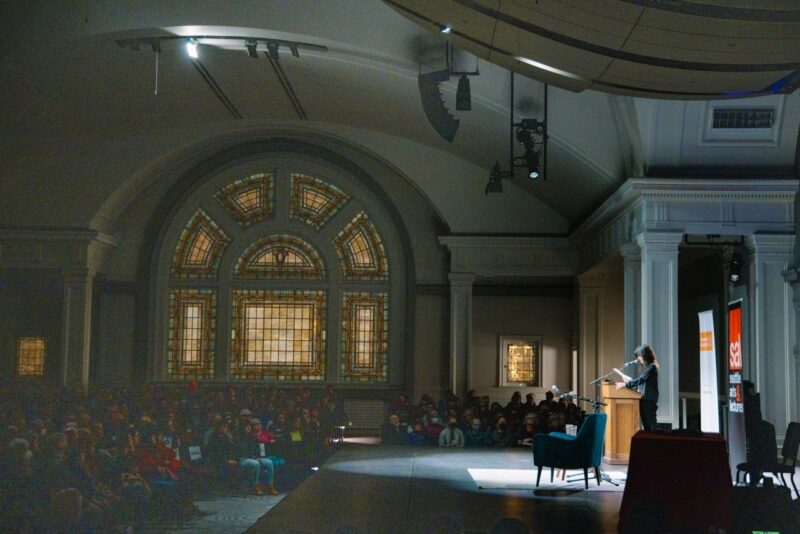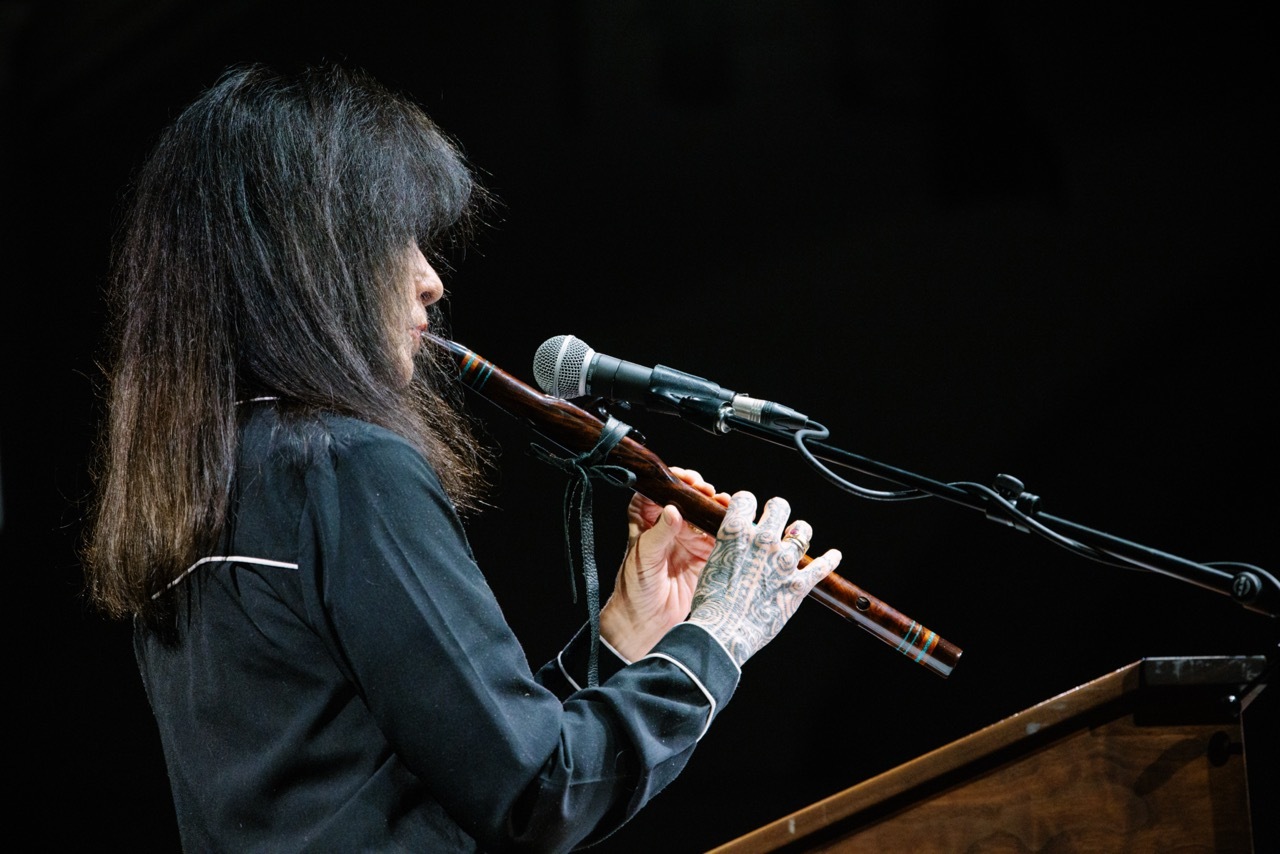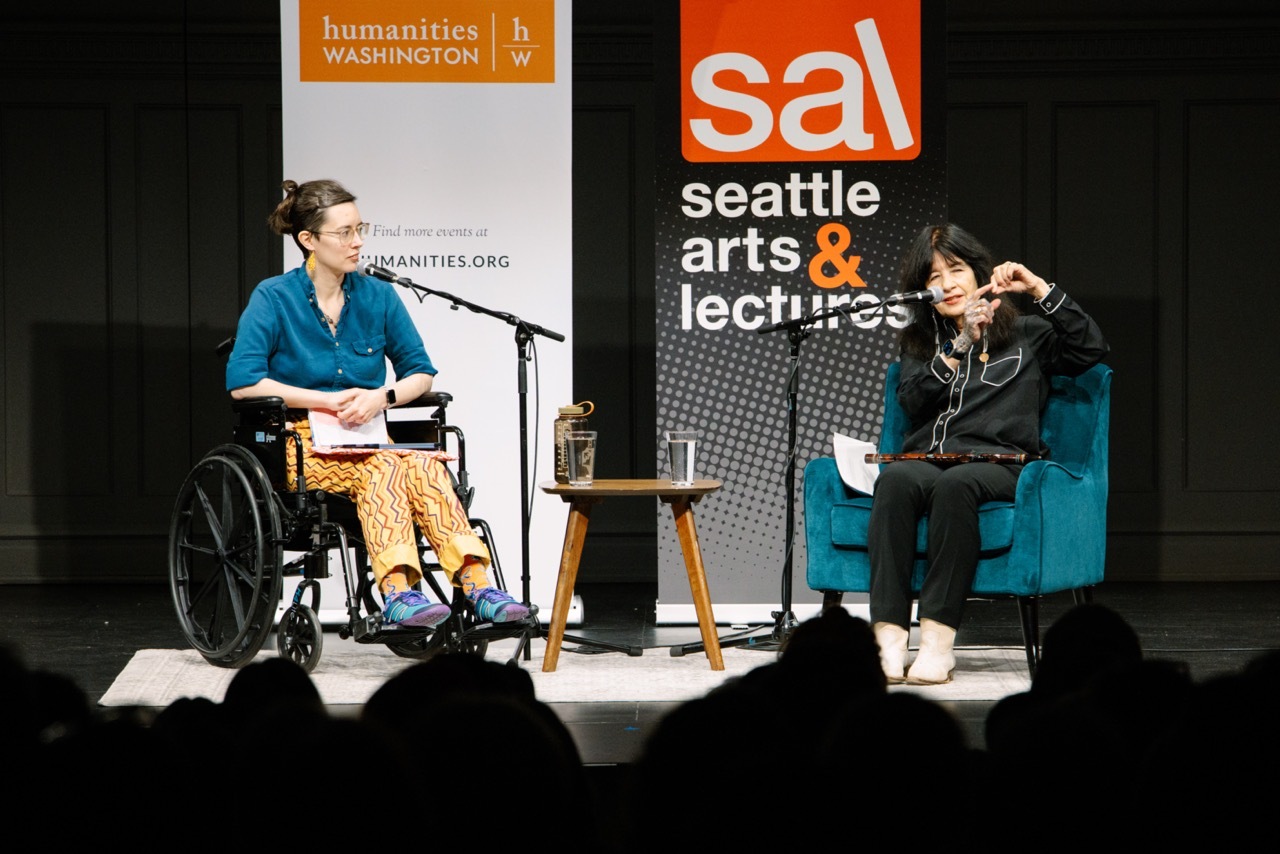The Gift of the Persistence of Life
Review of Joy Harjo at Seattle Arts & Lectures
Written by TeenTix Newsroom Writer Keona Tang and edited by Teen Editorial Staff Member Aamina Mughal

On February 27, Seattle Arts & Lectures hosted Joy Harjo, who performed a breathtaking blend of song, poem, and musing followed by a Q&A session with Arianne True, the current Washington State Poet Laureate.
The event began with a reading of “Dear Spanish” by Seattle’s Youth Poet Laureate Mateo Acuña. His poem reflected the frustrations and struggles of multicultural people like himself. The poem artfully moves from a bitter tone to an unending longing and desire to understand Spanish, to reconnect with what he loves and his Peruvian roots. His words and reading truly spoke to my experience as an American-born Chinese person, specifically with his reflections on accent, demonstrating a unique command of the poetic form. Acuña’s reading immediately set up a more intimate, almost conversational atmosphere, like he was sharing secrets that could either resonate with the audience or prime them with a mindset of understanding.
After Acuña’s reading, Harjo walked onto the stage with her flute and introduced herself to the audience. She described Seattle as a convergence of earth, sky, water, people, and cultures; a diverse and beautiful place. And one that we need to take care of it and each other. This set the stage for the themes of deep connections to nature and humanity, evident throughout Harjo’s performance, which was structured as a collection of 50 vignettes to tell her story as a person and an artist.

She began by recounting her first visit to Seattle in 1968 as part of the dance and theater show group Deep Roots Tall Cedar. At the time, she had only just turned 17 – my age now. Harjo’s drive towards artistic creation was there from the start, originally manifesting in dance and theater. She went on to paint the late 1960s with turbulent politics and growing native rights movements, and the impact of young Indigenous artists in shaping culture. In essence, Harjo explained the importance of artists, especially those in families, because “every art has a genealogy” that keeps track of the past, and present, and thus understanding of the future. Like her memoir Poet Warrior’s cover, our identities are a web of people and stories that came before us and those that walked with us through life.
In college, she was inspired by the words of Indigenous poets and activists, powerful orators who called for action, and her first works focused on misogyny and racism. Despite being unable to attend protests at the time due to her pregnancy, Harjo began to fight by writing. Harjo reflects that she’s recently realized that her daughter, always an inspiration, was also always in her poetry. Thus, she began by honoring her daughter—a mother, warrior, and artist—and the gift of persistence in life.
A few minutes into her performance, Harjo played a short piece on her flute to honor this gift and the convergence of forces—water, earth, guardians—that brought everyone there together. The echo of the space brought an even more ethereal and goosebump-inducing quality to the song. The scales she played flowed like water through the air, beckoning a more spiritual part of myself, and making me want to believe. She then read a piece about prayers and how in times of brokenness, looking for stories that nourish us. Harjo explains how Indigenous languages carry not only communication but also plants, animals, star maps, meaning, and more. Though she considers English a trade language, it was used as a weapon when destroying Indigenous peoples.

In the last segment of the event, True conducted a Q&A interview with Harjo with some audience questions. When asked about creating her work, she mentioned how it’s harder for women to make the time to write because of the roles and obligations they tend to have in the family and in communities. In her response, Harjo offered a reminder to artists, especially women, that they don’t have to ask permission to create. Harjo touches on the themes of colonialism, equality, and human connection intertwined with reflections on motherhood and Indigenous culture’s influence on current American culture.
True continues by asking how Harjo exists around the tropes of Indigenous poetry that can be essentialized or romanticized, particularly by a white audience, to which Harjo, somewhat humorously, replies that she ignores them. When she goes into her art, she’s somewhere else and the stories are of accomplishment rather than just trauma. Overall, I felt that these questions shed light on who Harjo is as a person, writer, and performer. Rather than keeping her separated from the audience as simply a performer, the interview let us see into her world as a person just like us.
The use of music and words helps us experience a fuller picture of Harjo’s ideas, and her nonlinear storytelling puts us in the place of her memories. Though at times hard to follow, the point is that we are not linear people. When True asked Harjo about the spider cover of Poet Warrior, Harjo replied that she was connecting things like the concentric circles of a spider’s web. Harjo remarks that we carry all the different stages of ourselves within us and there’s more to draw on when we’re older.
I felt that the change in the atmosphere of the Q&A session at the end almost broke the spell of Harjo’s performance. Although it might’ve been less sensible as they had to collect audience questions, having the Q&A session first might have allowed the audience to keep pondering the themes and hearing the music afterward. Harjo writes like a painter, drawing out worlds that help us see visionary potential. Her ideas are teachings that celebrate unseen heroes, cause us to think, and bring hope. I found the most comforting idea Harjo shared was that in stories nothing ever truly dies.
Lead Photo Credit: courtesy of Libby Lewis Photography
The TeenTix Newsroom is a group of teen writers led by the Teen Editorial Staff. For each review, Newsroom writers work individually with a teen editor to polish their writing for publication. The Teen Editorial Staff is made up of 5 teens who curate the review portion of the TeenTix blog. More information about the Teen Editorial Staff can be found HERE.
The TeenTix Press Corps promotes critical thinking, communication, and information literacy through criticism and journalism practice for teens. For more information about the Press Corps program see HERE.


